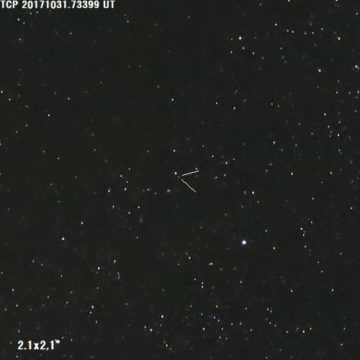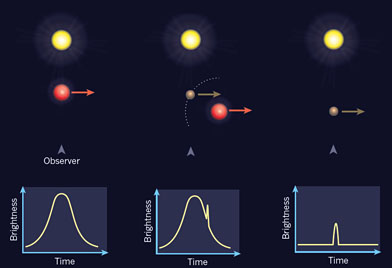Follow-up observations of an amateur-discovered system show that the planet orbits its star at the snow line, where ice giants may form.

T. Kojima / AAVSO
Through the fall and winter of 2017, a team of astronomers used a baker’s dozen of telescopes distributed around the globe to follow a star in the constellation Taurus. Now, they’re reporting that the data they collected that winter has confirmed the existence of a Neptune-mass planet in the outskirts of our galaxy.
On October 25, 2017, amateur astronomer Tadashi Kojima in Gunma Prefecture, Japan, was monitoring stars, looking for any sudden brightening that might indicate a nova. He had scanned the same field in Taurus, on September 2nd, but his newer observations revealed that one particular star, which had been magnitude 13.0 in September, was now magnitude 11.7. By Halloween, the star had brightened further to magnitude 10.8.
The star was still a faint piece of fuzz in Kojima’s observations, but the call for follow-up observations (via the American Association for Variable Star Observers and the Central Bureau for Astronomical Telegrams) soon showed that the brightening he had observed was part of a pattern characteristic of gravitational microlensing.

When one star passes directly behind another from Earth’s perspective, general relativity tells us that the foreground star’s gravity will bend the light from the background star. To Earthlings, this appears as a days-long brightening of the star before it fades away again. If the foreground star has a planet, the “gleam-and-fade” pattern will hiccup. The planet’s gravity adds a brief flash to the overall brightening.
Astronomers, including amateurs, monitor the sky for such microlensing events. They’ve found several dozen so far, most of them in wide orbits around their stars. But the event that Kojima discovered, named Kojima-1, is unique. For one, most microlensing events occur toward the galactic center, as there are more stars in that direction, but Kojima’s star is in the sparser region opposite the center. The star’s nearby, too, only some 1,600 light-years away. The galactic center, for comparison, is 26,000 light-years from Earth.
Because the foreground star is in an uncrowded region and closer to Earth than the typical microlensing star, it made for an easy target for follow-up observations. Multiple observing campaigns ensued, including one led by Akihiko Fukui (University of Tokyo). His team used 13 ground-based telescopes to repeatedly image the star and obtain its spectrum over the next 2½ months.
In the November 1, 2019, Astronomical Journal, the team reports the results of those observations: the planet’s mass is 20 times that of Earth, making it slightly more massive than Neptune, and its orbit is similar to Earth’s. Designated Kojima-1Lb, the planet orbits its star at 1.1 astronomical units (a.u.). But because the star is less massive and less luminous than the Sun, that orbit puts the exo-Neptune not in the habitable zone but at the edge of the snow line, beyond which water vapor and other gases condense into ice. Neptune-mass planets might be common at this edge.
Among microlensing stars, the one that hosts Kojima-1Lb is the brightest known. Most microlensing systems are distant and quite faint, but Kojima’s star is different. Using cutting-edge or next-gen telescopes, astronomers may one day study the Neptune-mass planet itself.
 4
4









Comments
fif52
November 10, 2019 at 5:49 pm
TCP J05074264+2447555
Also this is RA 05h 07m 42.64s DEC +24°47'55.5"
Near Aldebaran and very near NGC 1746 in the constellation Taurus.
You must be logged in to post a comment.
genepoz
November 13, 2019 at 5:12 am
Can you tell us what kind of equipment Mr. Kojima used to see and measure this star and its changes in brightness. This would seem to me to be of the most interest to other amateurs and would-be amateurs, yet it does not appear to be mentioned in any of the articles I've read about this.
Thanks
You must be logged in to post a comment.
Sabrina Garvin
November 13, 2019 at 11:26 am
Hi genepoz,
Mr. Kojima was using a Canon EOS 6D + 135-mm f3.2 lens. For more information you can visit this website.
http://www.aavso.org/taurus-microlensing-event
You must be logged in to post a comment.
Monica YoungPost Author
November 15, 2019 at 4:33 pm
Yes, the AAVSO lists his equipment for this event: Canon EOS 6D + 135-mm f3.2 lens with the limiting mag.= 13.0.
You must be logged in to post a comment.
You must be logged in to post a comment.